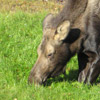Plant nutrition and moose productivity
by Kathleen McCoy |
What determines a healthy moose population? Many biologists have previously focused primarily on the quantity of winter food available to moose and neglected the summer nutritional factor in population dynamics. Advancing new research methods that determine how moose are influenced by plant nutrition are UAA biology professor Donald Spalinger and his team.
Moose depend on plants not only to survive, but the types, quality, and availability also control moose productivity. The nutritional relationship between tannins and plant protein is critical to moose development and survival. Tannins are compounds that occur naturally in the stems and leaves of most plants moose depend on. In high quantities, these tannins disrupt protein absorption in winter and summer, which negatively impacts moose reproductive rates. For example, a healthy cow will have twins as much as 75 percent of the time, and triplets are not uncommon. Protein-deficient cows are more likely to have only one calf or perhaps none at all.
 Moose are important to Alaskans for hunting, subsistence and wildlife viewing. A healthy
population of moose in the state is desirable for all these reasons. When populations
drop, the finger commonly gets pointed at predators like wolves. Spalinger explains
that in an effort to rectify the problem, controversial programs like aerial wolf
hunting have created a black eye for the conservation effort in Alaska. But it is
often not certain that predators are the only or even the main reason for a moose
population's decline.
Moose are important to Alaskans for hunting, subsistence and wildlife viewing. A healthy
population of moose in the state is desirable for all these reasons. When populations
drop, the finger commonly gets pointed at predators like wolves. Spalinger explains
that in an effort to rectify the problem, controversial programs like aerial wolf
hunting have created a black eye for the conservation effort in Alaska. But it is
often not certain that predators are the only or even the main reason for a moose
population's decline.
Spalinger's comparison of tannin levels in moose forage in two areas of Interior Alaska shows that tannins and their impact on protein digestion may explain differences in moose productivity. Moose browse in the Nelchina Basin is consistently high in tannins, which inhibit protein absorption rates. Modeling has shown that moose in the Nelchina Basin may be protein-deficient for a substantial part of the year, which could result in much lower calving rates, leading to declining moose populations. The browse in Denali National Park has also been analyzed, and tannins levels are significantly lower, and protein levels higher, than those of Nelchina Basin, which results in higher rates of dietary protein absorption. The Denali herd is a much healthier herd, experiencing higher calving rates consistent with other measures of body condition.
Spalinger and his team have been invited to expand their nutritional research to several additional moose populations in the State, including the Colville River area on the North Slope and the Togiak National Wildlife Refuge near Dillingham. They began working in these areas in 2009. One of Dr. Spalinger's graduate students is also working on the Kenai Peninsula in collaboration with the Chugach National Forest Office to examine the nutritional composition of moose browse in areas treated to increase browse productivity for wildlife. Likewise, the models of moose-carrying capacity that Spalinger and his collaborators have been developing are now being applied in the Chugach National Forest, as well as the Yukon Flats National Wildlife Refuge to evaluate the nutritional conditions and how it might affect moose population productivity.
Previously, determining tannins and their interaction with proteins was pricey and laborious. Spalinger's research team modified the method to decrease cost and labor -- tannin measurement that took hours now takes minutes using a patented technique called Accelerated Solvent Extraction (ASE). Now, relevant nutrition data can be obtained in a fraction of the time and at a lower cost.
This wealth of new data, in combination with studies on other factors affecting habitat, helps us understand the mechanisms that control moose populations. Spalinger believes we are finally perfecting the technologies, physiological and ecological understanding necessary to see the big picture of moose habitat ecology. This creates an efficient system of techniques and methods that wildlife management can use to best determine how to preserve the Alaska moose at optimal levels in a healthy habitat.
Read more about this research:
McArt, S. H., D. E. Spalinger, W. B. Collins, E. R. Schoen, T. Stevenson, and M. Bucho. 2009. Summer dietary nitrogen availability as a potential bottom-up constraint on moose in south-central Alaska. Ecology 90:1400-1411.
McArt, S. H., D.E. Spalinger, J.M. Kennish, and W.B. Collins. 2006. A modified method for determining tannin-protein precipitation capacity using accelerated solvent extraction (ASE) and microplate gel filtration. Journal of Chemical Ecology 32:1367-1377.
 "Plant nutrition and moose productivity" is licensed under a Creative Commons Attribution-NonCommercial 4.0 International License.
"Plant nutrition and moose productivity" is licensed under a Creative Commons Attribution-NonCommercial 4.0 International License.









